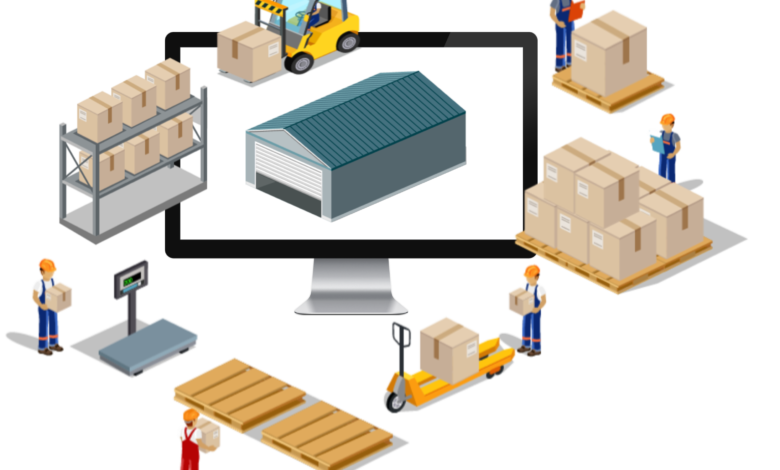The Power of Inventory and Warehouse Management Software in Streamlining Operations

Introduction: Management of a company’s warehouse and inventory must be done well for it to be advantageous for companies of any size or sector. The capacity of a corporation to accurately track and control inventory levels, minimize storage space, and streamline order fulfillment operations can have a significant impact on the bottom line of the organization.
Software for inventory and warehouse management is becoming increasingly popular in today’s digital age as a means for firms to improve their operational efficiency and preserve a competitive advantage. In this post, we will discuss the advantages of using inventory and warehouse management software, as well as its features and the factors to consider while using it.
The Importance of Proper Inventory and Storage Facility Management
The successful operation of a firm is directly correlated to how well it manages its warehouse and inventory. First and foremost, ensuring that inventory levels are kept at the correct level enables businesses to satisfy the demands of their customers without incurring excessive carrying costs or running out of stock.
If a company effectively tracks its inventory levels, it can reduce the likelihood of either overstocking or running out of essential commodities, increasing both customer satisfaction and the likelihood that they will continue to do business with the company.
Second, effective management of warehouse space enables companies to make the most of the space they have available for warehousing. Because there is a finite amount of real estate, it is essential to make the most of the space that is available in order to cut down on the costs of warehousing.
Businesses are able to organize their items in a methodical manner, optimize the allocation of space, and streamline the picking and restocking operations with the help of effective warehouse management software.
The Advantages of Utilizing Software for Inventory and Warehouse Management
There are a variety of advantages that may be gained by organizations, regardless of their size or sector, through the utilization of inventory and warehouse management software. Let’s take a closer look at some of these benefits:
A. Real-Time Inventory Visibility Inventory management software enables firms to monitor stock levels, track item locations, and spot potential stockouts by providing real-time visibility into inventory levels. This visibility enables improved inventory planning and helps to guarantee that firms are able to rapidly meet the demands of their customers.
B. Improved Order Fulfillment: By integrating order management and inventory systems, firms can streamline order fulfillment operations. Software designed for inventory and warehouse management makes it possible to accurately pick, pack, and dispatch orders, thereby lowering the rate of errors and increasing overall productivity.
C. Decreased carrying expenditures: Excess inventory not only consumes precious capital but also results in additional expenditures for storage. Businesses are able to optimize inventory levels, reduce the amount of overstocking they do, and prevent unnecessary carrying expenses when they use inventory management software. This streamlined method improves cash flow while simultaneously increasing profitability.
D. Enhanced Accuracy and Productivity: Manual inventory management methods are prone to errors, which leads to inaccuracies in stock levels and order fulfillment. Automated inventory management processes, on the other hand, improve both accuracy and productivity.
By using software to automate these procedures, organizations can reduce the number of errors caused by human workers and enhance their overall accuracylfillment. Automated inventory management processes, on the other hand, improve both accuracy and productivity.
E. Insights That Are Data-DrivenInventory and warehouse management software can provide extensive reports and analytics, which can provide useful insights on inventory turnover, demand trends, and the effectiveness of operational procedures. These insights give companies the ability to make decisions based on data, enhance inventory levels, and improve overall performance, and to do so more effectively. Data access must be controlled, however, using security models like least privilege principle.
Key Characteristics of Inventory and Storage Area Management Software
Software used to manage inventories and warehouses often includes a variety of functions that are intended to simplify administrative tasks. When choosing software, you should give careful consideration to the following essential features:
A. Inventory Tracking: The program should offer real-time visibility into inventory levels, enabling firms to monitor item movements and track stock across several locations.
B. Demand Forecasting: Businesses that have access to accurate demand forecasting capabilities are able to anticipate customer demand and adjust inventory levels accordingly, thereby reducing the likelihood of stockouts and overstocking.
C. Order Management: Effective order processing, correct picking, and timely fulfillment are all guaranteed by an order management system that is seamlessly integrated with the inventory management system.
D. Integration of Barcodes and RFID: Integration of barcodes with radio-frequency identification (RFID) technology enables accurate and efficient product identification, which in turn reduces the number of mistakes made and improves inventory management.
E. Reporting and Analytics: Companies that have comprehensive reporting and analytics capabilities are able to acquire insights into the performance of their inventories, the efficiency of their operations, and the accuracy of their order fulfillment.



